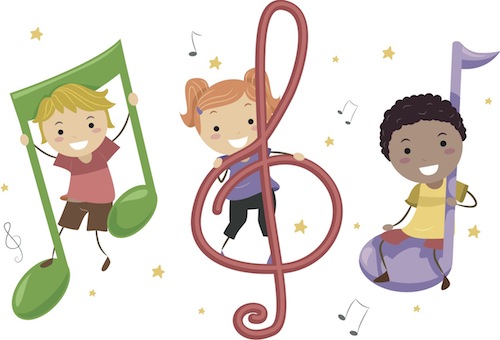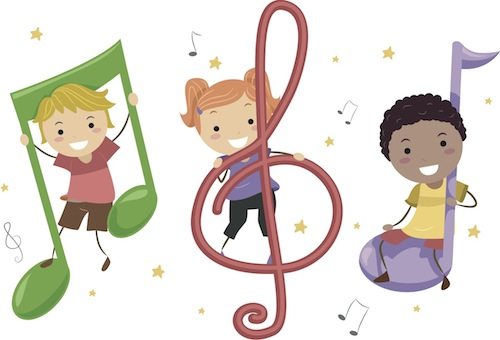You don’t have to be a skilled musician yourself to teach music in your homeschool classroom. Discover the benefits of music in your homeschool classroom by incorporating fun and educational music activities into your daily routine.
Music enhances skills that lead to success both inside and outside the classroom, including social, math, and language skills[1][2]. Try the online resources below in your classroom that make music learning easy and fun for both student and teacher.

The Internet offers great music resources for the homeschool classroom like the KinderBach Video Series and fun music quizzes from Easy Ear Training. Easy online KinderBach YouTube videos provide young students with simple music lessons on ear training, music theory, and piano. For more interactive fun, try out 7th Chords with Chordelia and learn intervals with the popular app RelativePitch.
Music learning videos
In the video below homeschooled students can learn musical patterns through simple ear training exercises like KinderBach[3]. This type of musical activity touches both on aural theory skills and mathematical pattern recognition as children learn to associate simple musical melodies with visual patterns. The visual patterns are child-friendly and relate easily to actual music notation. Homeschool educators can extend the lesson to include basic counting techniques or include advanced discussions on acoustics and pitch for older students.
Check out online videos, lesson plans, and other great ear training and music theory homeschool materials at Karri Gregor’s KinderBach website: http://www.kinderbach.com/
Music learning games
Educational computer games combine fun and music learning. Play Theta Music’s ear training games with your music or computer skill lesson plans or use them as educational enrichment in the homeschool classroom.
Creating a free account gives you access to the beginner levels of all Theta Music Trainer Games. Fun music games like Parrot Phrases and the Dango Brothers work on critical thinking, vocabulary, mathematical relationships, patterns, ear training, and technology skills. The site offers several free games that explore harmony, melodies, intervals, chords, and instrumentation.
Find out more about mastering music fundamentals at the Theta Music Trainer Website.
Musical Colors
Even homeschool educators without ear training experience can use a simplified version of the Brainin Method[4] to learn basic ear training, sight singing, and pitch recognition. Developed over three decades by European educator and scholar Valery Brainin, the Brainin Method uses colors and simple pattern association to teach ear training and pitch.
The Brainin Method uses the color chart shown in the video to associate certain colors and emotional feelings with relative pitch. “Do” or the tonic (ex. “C” in the C Major Scale) is shown in the calming color of green (center rectangle). The pleasant sounding pitches of a fourth and a fifth also have cool colors. Sharp-sounding intervals like the minor second or a tritone have jarring warm colors like red or yellow.
Did you know: Composers like Rimsky-Korsakov and Scriabin used similar color association in their compositions.
Read more about the Brainin Method and the use of color in ear training exercises and development. The site includes helpful pdfs that describe the science behind the Brainin Method and a simple Rhythmic Patterns worksheet, as well as additional links to other Brainin Method sites. http://www.brainin.org/
Musical Quizzes
If you are looking for an easy way to add interactivity and technology to your music class, try the fun music quizzes on drums, ear training, and frequencies at Easy Ear Training. Helpful articles and tutorials on a variety of topics like guitar, percussion, and acoustics accompany each fun music quiz and are an excellent resource for the homeschool educator. Check out the latest here:
If you need to brush up on your music knowledge, our education resources help you learn how music impacts each stage of life, from the womb to adulthood in this Music & Life series, which covers interesting topics on education, music and memory, and child development. Also check out innovative series like Frequency Fundamentals and Pitch & Harmony to develop your ears and musical skills.
Need to find out more about music theory, ear training, audio, and playing by ear? The Easy Ear Training site provides dozens of free resources through insightful music articles written by talented professionals and educators. https://www.musical-u.com/
With all of these amazing online resources, adding fun music games to your homeschool classroom is easy and fun!
We want to hear from you! What are some ways that you incorporate ear training and music theory in your homeschool classroom? Share your favorite music resources below!
Show article sources
Sources
- Children’s Music Workshop (2012). Benefits of Music. Music Education Online. http://www.childrensmusicworkshop.com/advocacy/benefits.html
- Ray, B. D. (2010). Academic Achievement and Demographic Traits of Homeschool Students: A Nationwide Study. Academic Leadership (15337812), 8(1), 1-26.
- KinderBach. (2012). Interview Karri Gregor on the KinderBach App . Retrieved from https://www.youtube.com/watch?v=1EZRZf48pyQ&list=UUJA_xHhGPm0FXI64pkj_USw&index=1&feature=plcp
- Brainin, Valeri. (2004). Employment of Multicultural and Interdisciplinary Ideas in Ear Training (“Microchromatic” Pitch. “Coloured” Pitch). International Society for Music Education 28th World Conference, Bologna, Italy.









Great post and links! We have many home school families using DLP for their music learning curriculum. Available for 35+ instruments – from beginner to advanced material and fantastic resources! http://www.dlpmusicprogram.com
Musical ability may not be necessary to teach it, but having the skills sure do help a lot. If anything, children will be able to learn quicker through example.
Homeschooling families have many more opportunities today in music. Whether you teach your child music from home, have your child participate in band/chorus, or simply incorporate music into everyday life, you are enriching your child's life and education. My mother home-schooled my siblings, and they enjoyed the great variety of opportunities that homeschooling offered. Music can be a part of that enriching experience! :) Great comment!
Hello Nicole,
Fortunately there are many ways to incorporate music into a child's life, even if you don't have "formal" training. Sing with your child, take your child to a kid-friendly concert, enjoy jamming to rhythmic Latin or West African music on homemade instruments, play a variety of music at home…there are so many ways that you can expose your child to music. I would suggest learning basic keyboard together (there are great resources online for this), going to a kid-friendly parent/child music class, taking a kid-friendly dance class, or singing in a community choir together. These are easy ways to learn music together as a family. :) Thanks for commenting!
Your Brianin link is broken – it's not the right page. Do you know where the info has moved to?
Hi Emma,
Thank you for letting us know! Please try http://www.brainin.org/Method/index_en.html instead. We've updated this link in the article – thanks!